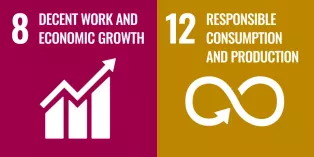UN Sustainable Development Goals
We are passionate about addressing the world’s challenges, and we have identified a wide range of the United Nations’ Sustainable Development Goals (SDGs) that our research helps address.
The United Nations set up 17 goals to achieve a better and more sustainable future for all. They are a universal call to action to end poverty, protect the planet and improve the lives and prospects of everyone, everywhere. The 17 Goals were adopted by all UN Member States in 2015.
Read about sustainable development at the UN site
Sustainable Development Goals we aim to address
SDGs 3, 6, 10 and 14: Healthy lives, well-being for all, clean water, and equality.
We develop knowledge and diagnostic tools that have the potential to help address infant mortality (3.2), reduce contagious (3.3) and non-contagious (3.4) diseases, and help ensure accessible health care (3.8) and equality (10). Our work on nanosafety aims to reduce risks for exposure to toxic materials (3.9) at the workplace and by reducing pollution (6.3, 14.1, 14.2). Effective water purification is an application of LED technology (6.1, 6.2).
SDG 7: Affordable and clean energy.
A significant part of our materials development, as well as basic and device research, aim to increase the share of renewable energy (7.2) through increased energy efficiency (7.3) and enabling improved infrastructure (7b).
SDGs 8 and 12: Economic growth and sustainable production.
We aim to create new nano-enabled products and industry sectors with a safe-by-design perspective addressing workplace safety (8.8), encouraging and enabling companies to adopt sustainable practices (12.6), including concerning waste generation (12.3) and management (12.4) with a life-cycle perspective (12.4).




